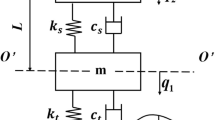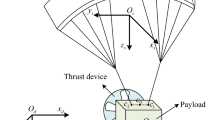Abstract
Parafoil is a kind of flexible aircraft, which has strong load capacity and long flight time but is easily disturbed by wind field. In the homing stage of parafoil from a high-altitude wind field to a low-altitude wind field, the low-altitude wind field is unmeasurable, which has a bad effect on the parafoil trajectory planning. To solve this problem, longitudinal prediction of the low-altitude wind field is proposed by intelligent processing of the high-altitude wind field data estimated by the parafoil. Since spatial wind field has the characteristics of hierarchical recursion and dynamic change, a deep deterministic policy gradient prediction model with Elman neural network as the core is proposed in this paper. Finally, the prediction effect of high accuracy and low-level precision attenuation, which provide reference information for the parafoil track planning, is realized.











Similar content being viewed by others
References
Prakash O, Ananthkrishnan N (2004) Aerodynamics, longitudinal stability and glide performance of parafoil/payload system preliminary project report. Ph.D. thesis, 08 2004
Sun H, Sun QL, Chen ZQ, Tao J, Luo SZ, Zeng XY, Teng SH, Zhou P (2020) An optimal-multiphase homing methodology for powered parafoil systems. Optimal Control Appl Methods 41(03):2020
Zhao L, Jianyi K (2009) Path planning of parafoil system based on particle swarm optimization. In: 2009 international conference on computational intelligence and natural computing, vol 1, pp 450–453
Yi GX, Wang SY (2017) Study on adaptive homing algorithm for parafoil system under the condition of unknown wind field. Transducer & Microsystem Technologies
Nitin M, Dineshkumar M, Arun Kishore WC (2013) Parafoil trajectory comparison for optimal control and proportional controller. In: 2013 International Conference on Control Communication and Computing (ICCC), pp 227–232
Inken P (2008) Comparative in-flight and wind tunnel investigation of the development of natural and controlled disturbances in the laminar boundary layer of an airfoil. Exp Fluids 44:961–972
Rodriguez L, Cobano JA, Ollero A (2016) Wind field estimation and identification having shear wind and discrete gusts features with a small UAS. In: 2016 IEEE/RSJ International Conference on Intelligent Robots and Systems (IROS), pp 5638–5644
Tao J, Sun QL, Tan PL, Wu WN, He YP (2017) Homing control of parafoil systems in unknown wind environments. Hangkong Xuebao/Acta Aeronautica et Astronautica Sinica 38(5):2017
Feng G, Zhang GB, Zhang MY, Zhang QB (2019) Study on trajectory planning of parafoil homing under variable wind field, pp 294–2944
Luo SZ, Sun QL, Tan PL, Sun MW, Chen ZQ, He YP (2019) Soft landing control of unmanned powered parafoils in unknown wind environments. Proc Inst Mech Eng 233(3):949–968
Gnana Sheela K (2011) Computing models for wind speed prediction in renewable energy systems. IJCA Spec Issue Comput Sci New Dimens Perspect 3:108–111
Guo ZH, Zhao WG, Lu HY, Wang JZ (2012) Multi-step forecasting for wind speed using a modified EMD-based artificial neural network model. Renew Energy 37(1):241–249
Akaike H (1974) New look at statistical-model identification. IEEE Trans Autom Control AC19(6):716–723
Torres JL, Garcia A, Blas MD, Francisco AD (2005) Forecast of hourly average wind speed with ARMA models in Navarre (Spain). Sol Energy 79(1):65–77
Zhou S, Yuan J, Song Z, Tang J, Kang L (2013) Wind signal forecasting based on system identification toolbox of MATLAB. https://doi.org/10.1109/ISDEA.2012.388
Al-Yahyai S, Gastli A, Charabi Y (2013) Probabilistic wind speed forecast for wind power prediction using pseudo ensemble approach. In: 2012 IEEE international conference on Power and Energy (PECon), pp 127–132
Shi WH, Chen J (2011) Reliability assessment of interconnected generation systems based on hourly wind speed probability model. Energy Procedia 12:819–827
Cao Q, Ewing BT, Thompson MA (2012) Forecasting wind speed with recurrent neural networks. Eur J Oper Res 221(1):148–154
Lahouar A, Ben Hadj Slama J (2014) Wind speed and direction prediction for wind farms using support vector regression, pp 1–6
Dowell J, Weiss S, Infield D (2014) Spatio-temporal prediction of wind speed and direction by continuous directional regime. In: 2014 international conference on Probabilistic Methods Applied to Power Systems (PMAPS), pp 1–5
Damousis IG, Alexiadis MC, Theocharis JB, Dokopoulos PS (2004) A fuzzy model for wind speed prediction and power generation in wind parks using spatial correlation. IEEE Trans Energy Convers 19(2):352–361
Razavi S, Tolson BA (2011) A new formulation for feedforward neural networks. IEEE Trans Neural Netw 22(10):1588–1598
Samala R, Chan HP, Hadjiiski L, Helvie M, Richter C (2020) Generalization error analysis for deep convolutional neural network with transfer learning in breast cancer diagnosis. Phys Med Biol 65(03):2020
Ali M, Sarwar A, Sharma V, Suri J (2017) Artificial neural network based screening of cervical cancer using a hierarchical modular neural network architecture (HMNNA) and novel benchmark uterine cervix cancer database. Neural Comput Appl. https://doi.org/10.1007/s00521-017-3246-7
Mohandes M, Halawani T (1998) A neural networks approach for wind speed prediction. Renew Energy 13:345–354
Hayashi M, Kermanshahi B (2001) Application of artificial neural network for wind speed prediction and determination of wind power generation output. In: Proceedings of ICEE
Fonte PM, Silva GX, Quadrado JC (2005) Wind speed prediction using artificial neural networks. WSEAS Trans Syst 4:134–139
Sreelakshmi K, RamakanthKumar P (2008) Neural networks for short term wind speed prediction. World Acad Sci Eng Technol Int J Comput Electr Autom Control Inf Eng 42:721–725
Kanna B, Singh S (2013) Improved RNN and AWNN based wind power forecast using meteorological inputs
Hou C, Han H, Liu ZJ, Su M (2019) A wind direction forecasting method based on z\_score normalization and long short\_term memory, pp 172–176
Hinich MJ (2010) Time series analysis by state space methods. OUP Cat 47(3):373
Fujita TT (1990) Downbursts: meteorological features and wind field characteristics. J Wind Eng Ind Aerodyn 36(1):75–86
Chen Z, Li CG, Zhang ZT, Liao JH (2008) Model test study of wind field characteristics of long-span bridge site in mountainous valley terrain. J Exp Fluid Mech 22:54–59+67
Iqbal U, Wah TY, Ur Rehman MH, Shah JH (2020) Prediction analytics of myocardial infarction through model-driven deep deterministic learning. Neural Comput Appl 32(1):1–20
Su RP, Wu FG, Zhao JS (2019) Deep reinforcement learning method based on DDPG with simulated annealing for satellite attitude control system, pp 390–395
Ghosh S, Tudu B, Bhattacharyya N, Bandyopadhyay R (2017) A recurrent Elman network in conjunction with an electronic nose for fast prediction of optimum fermentation time of black tea. Neural Comput Appl 31(02):2019
Dou CX, Qi H, Luo W, Zhang YM (2018) Elman neural network based short-term photovoltaic power forecasting using association rules and kernel principal component analysis. J Renew Sustain Energy 10:043501
Zheng YM, Chen ZQ, Huang ZY, Sun MW, Sun QL (2020) Active disturbance rejection controller for multi-area interconnected power system based on reinforcement learning. Neurocomputing 04:2020
Joseph W, Frederic M, Cameron B, Simon D (2020) Improved reinforcement learning with curriculum. Expert Syst Appl 158(113515):2020
Zhang Y, Zhang ZF, Yang QY, An D, Li DH, Li C (2020) EV charging bidding by multi-DQN reinforcement learning in electricity auction market. Neurocomputing 397(404–414):2020
Schulman J, Levine S, Moritz P, Jordan MI, Abbeel P (2017) Trust region policy optimization
Schulman J, Wolski F, Dhariwal P, Radford A, Klimov O (2017) Proximal policy optimization algorithms
Sutton R, Barto A (1998) Reinforcement learning: an introduction
Jin LQ, Tian DY, Zhang QX, Wang JJ (2020) Optimal torque distribution control of multi-axle electric vehicles with in-wheel motors based on DDPG algorithm. Energies 13:1331
Tan P, Sun M, Sun Q, Chen Z (2020) Dynamic modeling and experimental verification of powered parafoil with two suspending points. IEEE Access PP(99):1
Acknowledgements
This work was supported by the National Natural Science Foundation of China (Grant Nos. 61973172, 61973175 and 62003177), the key Technologies Research and Development Program of Tianjin (Grant No. 19JCZDJC32800), this project also funded by China Postdoctoral Science Foundation (Grant No. 2020M670633).
Author information
Authors and Affiliations
Corresponding author
Ethics declarations
Conflict of interest
Conflict of interest The authors declare that they have no conflict of interest.
Additional information
Publisher's Note
Springer Nature remains neutral with regard to jurisdictional claims in published maps and institutional affiliations.
Rights and permissions
About this article
Cite this article
Yu, Z., Tan, P., Sun, Q. et al. Longitudinal wind field prediction based on DDPG. Neural Comput & Applic 34, 227–239 (2022). https://doi.org/10.1007/s00521-021-06356-1
Received:
Accepted:
Published:
Issue Date:
DOI: https://doi.org/10.1007/s00521-021-06356-1




